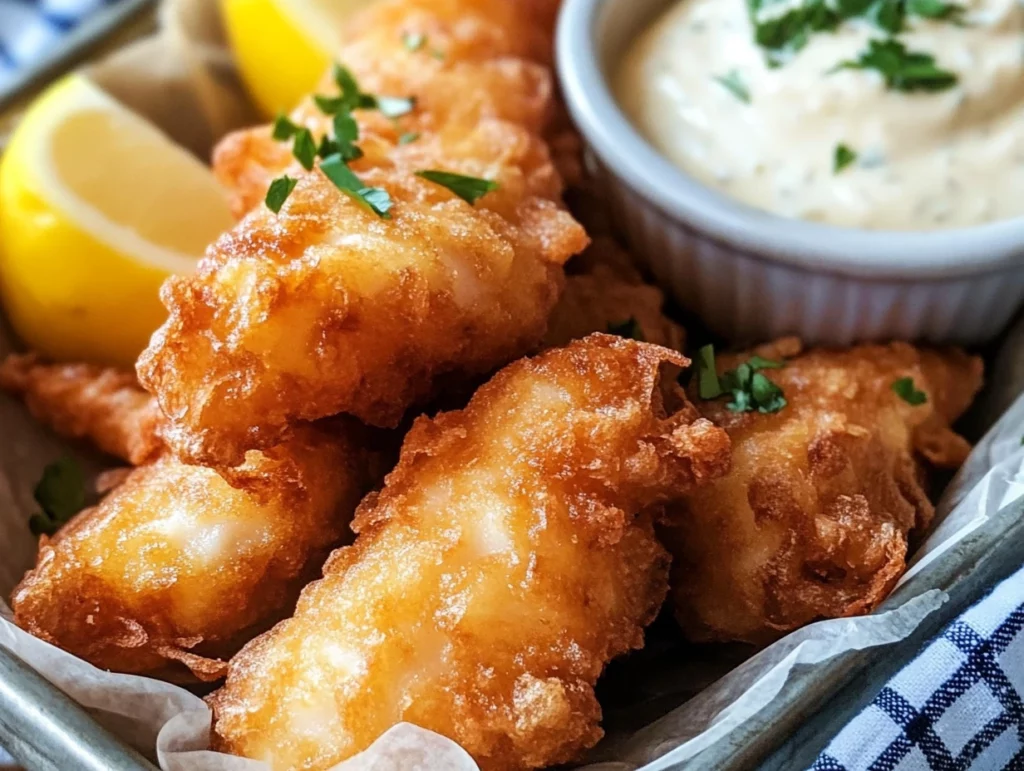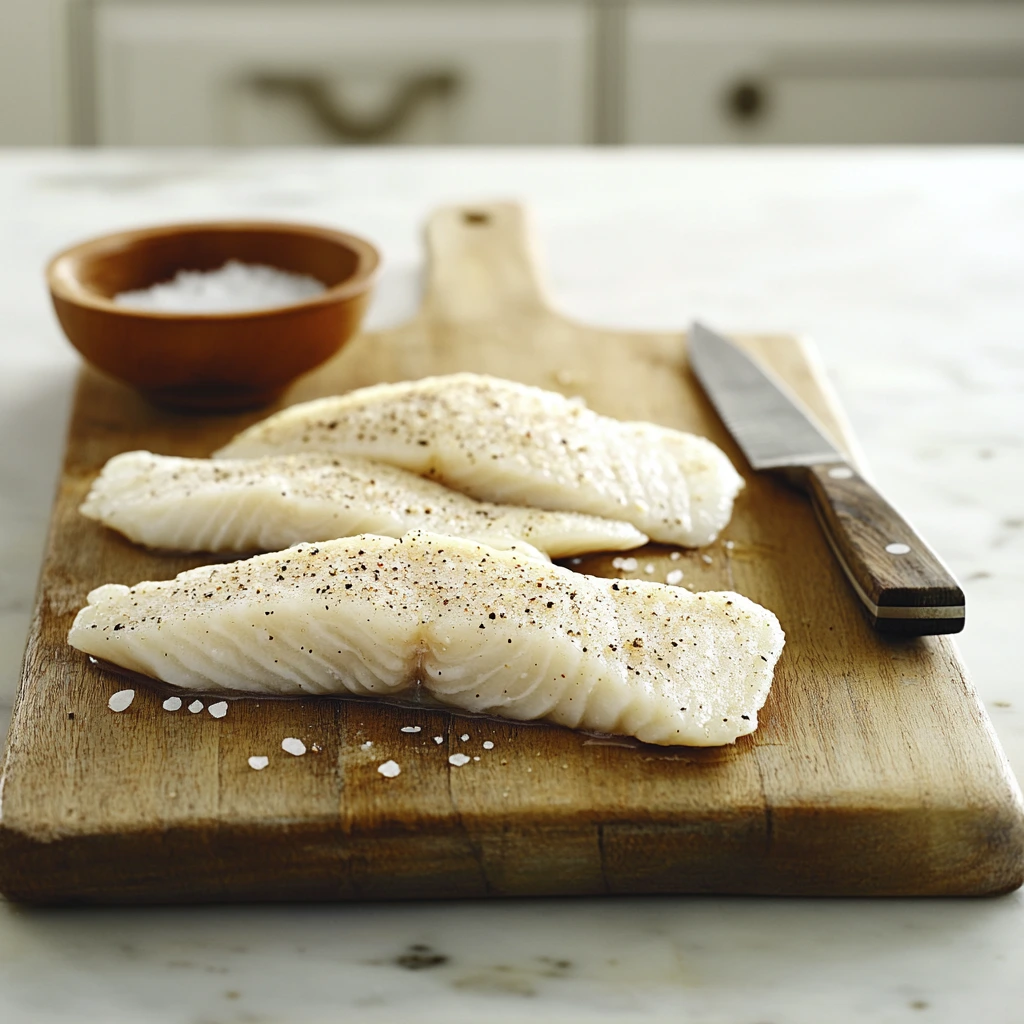There’s nothing quite like biting into a piece of perfectly fried fish—crispy on the outside, tender and flaky on the inside. If you’ve ever wondered how restaurants achieve that golden, crunchy coating, you’re in the right place! This crispy fish batter recipe is the key to homemade fried fish that tastes just as good (if not better) than your favorite seafood spot.
The secret? A light, airy batter made with a mix of all-purpose flour, cornstarch, and a splash of cold sparkling water or beer. Whether you’re making fish and chips for a family dinner or frying up a batch for a backyard fish fry, this recipe delivers every time.
Let’s dive into the step-by-step process to ensure your fried fish turns out perfectly golden and irresistibly crispy.
Step 1: Prepare the Fish
Before we even get to the batter, let’s talk about the fish. The best choices for frying are white, flaky fish like cod, haddock, or tilapia. These fish hold up well to frying and have a mild flavor that pairs beautifully with the crispy batter.
Start by patting the fish fillets dry with paper towels. This step is crucial because excess moisture can prevent the batter from sticking properly. A dry surface ensures the perfect crispy coating. Lightly season the fillets with salt and pepper, then set them aside while you prepare the batter.
Step 2: Mix the Batter
Now for the fun part—making the batter! A great crispy batter is all about balance. It needs to be light enough to puff up when fried but sturdy enough to coat the fish evenly.
In a mixing bowl, whisk together:
- 1 cup all-purpose flour
- ¼ cup cornstarch (this adds extra crunch)
- 1 teaspoon baking powder (for a light, airy texture)
- ½ teaspoon salt
- ¼ teaspoon black pepper
- 1 teaspoon garlic powder (optional, for extra flavor)
Next, slowly pour in 1 cup of cold sparkling water (or cold beer for a beer-battered twist). The carbonation in sparkling water or beer helps create a delicate, crisp coating. Gently whisk until the mixture is smooth, but be careful not to overmix—this can make the batter too dense. You want it just thick enough to coat the back of a spoon.
Once your batter is ready, set it aside while you heat the oil for frying.
Step 3: Heat the Oil
For deep frying, it’s essential to get the oil temperature just right. Too hot, and the batter will burn before the fish cooks through. Too cool, and the fish will absorb too much oil, making it greasy instead of crispy.
Pour vegetable oil into a deep skillet or fryer, making sure there’s enough to fully submerge the fish. Heat the oil to 350°F (175°C)—this is the sweet spot for crispy, golden-brown fish. If you don’t have a thermometer, you can test the oil by dropping in a small spoonful of batter. If it sizzles and rises to the top quickly, the oil is ready.
Now that the oil is hot and the batter is mixed, it’s time to coat and fry the fish!
Step 4: Coat the Fish
Now that your oil is heated and your batter is mixed, it’s time to coat the fish fillets. This step ensures that every bite is perfectly crispy and golden.
First, lightly dredge each fish fillet in all-purpose flour, shaking off any excess. This helps the batter stick better and creates an even coating. Skipping this step can result in the batter sliding off the fish while frying.
Next, dip each floured fillet into the batter, making sure it’s fully coated. Let any excess batter drip off before transferring the fish to the hot oil. This prevents the batter from being too thick, which can lead to uneven frying.
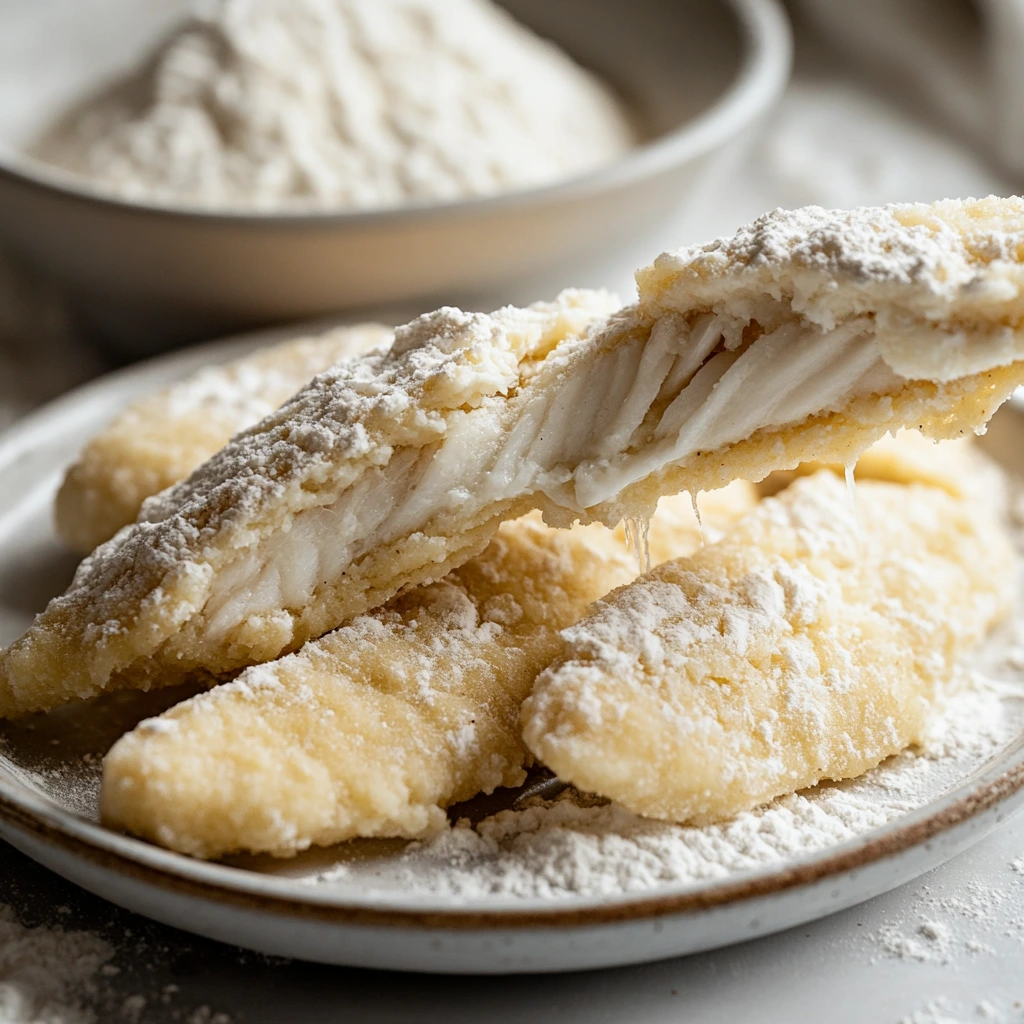
Step 5: Fry the Fish
Carefully lower the battered fish into the hot oil. It’s important to fry in small batches to avoid overcrowding the pan, which can lower the oil temperature and make the fish greasy instead of crispy.
Fry each piece for about 3 to 5 minutes per side, or until the batter is golden brown and crispy. The fish should be cooked through and flake easily with a fork. If you’re unsure, use a meat thermometer—the internal temperature should reach 145°F (63°C).
Once the fish is done, use a slotted spoon or tongs to remove it from the oil. Place it on a paper towel-lined plate to drain excess oil. If you’re frying multiple batches, keep the cooked fish warm by placing it on a wire rack in a 200°F oven until all the pieces are ready to serve.
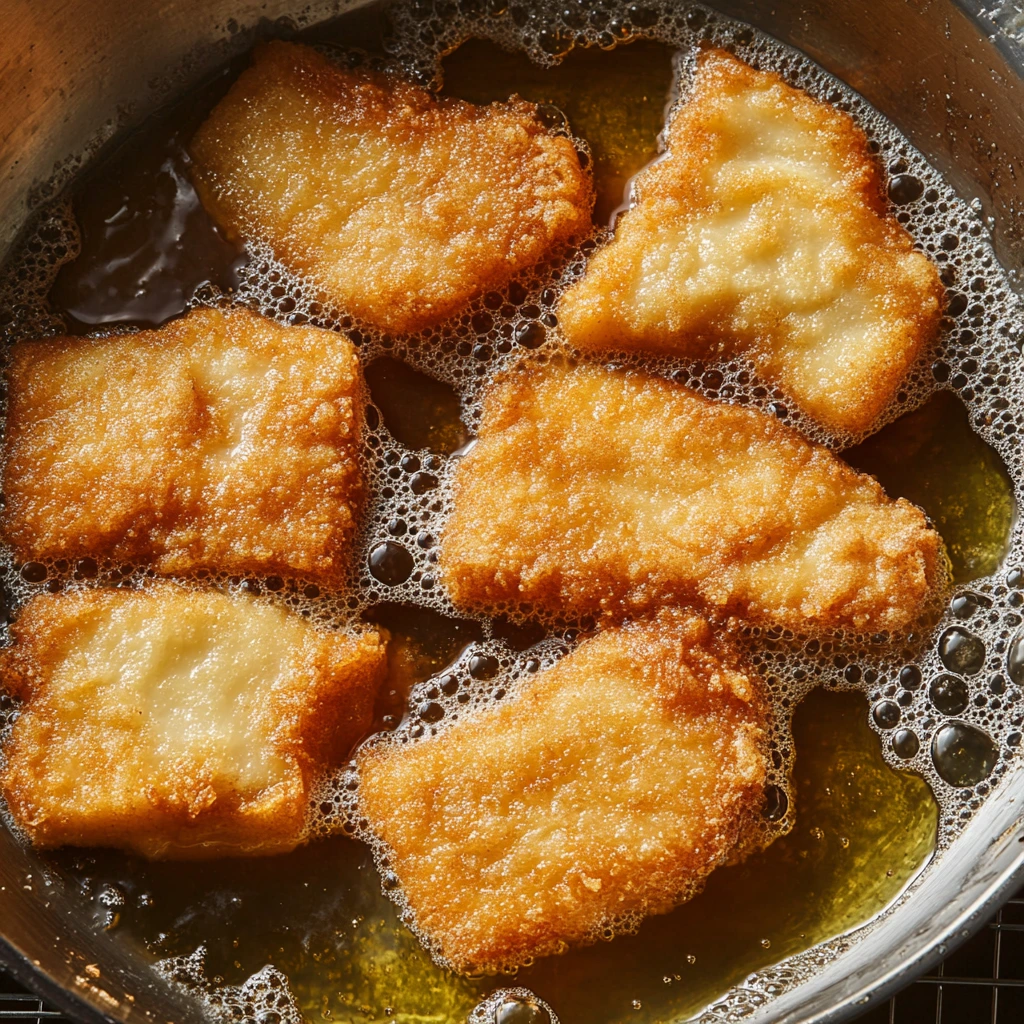
Step 6: Serve and Enjoy
Now for the best part—serving up your crispy, golden fish! Pair it with classic sides like:
- Tartar sauce – for a tangy, creamy dip
- Lemon wedges – for a fresh, citrusy kick
- Coleslaw – for a cool, crunchy contrast
- French fries – because nothing beats homemade fish and chips
For an extra touch, sprinkle a little salt over the fish as soon as it comes out of the fryer. This enhances the flavor and gives it that restaurant-style finish.
Pro Tips for the Crispiest Fish
Want to take your fried fish to the next level? Keep these expert tips in mind:
- Use ice-cold sparkling water or beer. The carbonation creates a light, airy batter that fries up extra crispy.
- Don’t overmix the batter. A few lumps are fine—overmixing can make it too dense.
- Keep the oil at the right temperature. If it’s too low, the fish will absorb oil and become greasy. If it’s too hot, the batter may burn before the fish is fully cooked.
- Drain on a wire rack instead of paper towels. This helps prevent the bottom from getting soggy.
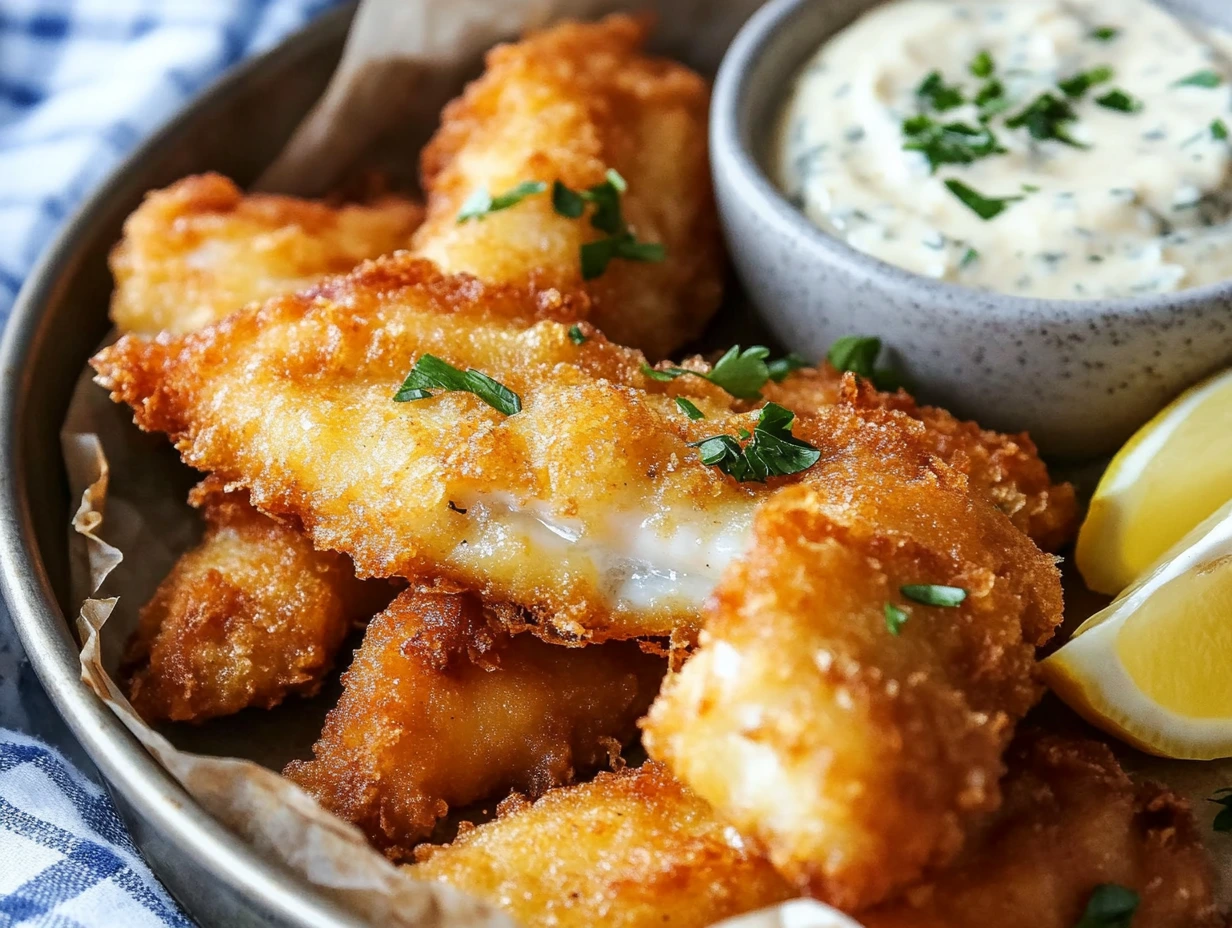
Frequently Asked Questions
Making crispy fried fish at home can be easy, but there are always a few questions that come up. Here are some of the most common ones to help you get the best results every time.
1. Can I use a different type of flour for the batter?
Yes! While all-purpose flour works best, you can experiment with rice flour or a mix of all-purpose and cornmeal for an extra crunchy texture. Rice flour, in particular, creates a lighter, crispier coating.
2. What’s the best oil for frying fish?
Vegetable oil, canola oil, or peanut oil are all great choices because they have a high smoke point and a neutral flavor. Avoid olive oil, as it has a lower smoke point and can make the fish taste bitter.
3. Can I make the batter ahead of time?
It’s best to mix the batter just before frying. The carbonation in the sparkling water or beer helps create a light, airy texture, and it loses its effect if the batter sits too long. If needed, you can prepare the dry ingredients in advance and mix in the liquid right before frying.
4. Why is my fried fish greasy instead of crispy?
If your fish turns out greasy, the oil temperature was likely too low. Make sure the oil is at 350°F (175°C) before adding the fish. Also, avoid overcrowding the pan, as this can lower the temperature quickly.
5. How do I store and reheat leftover fried fish?
Store leftovers in an airtight container in the fridge for up to 2 days. To reheat, place the fish in a 400°F oven for about 10 minutes to keep it crispy. Avoid microwaving, as it can make the batter soggy.
6. Can I use this batter for other foods?
Absolutely! This batter works great for shrimp, onion rings, and even vegetables like zucchini or mushrooms. Just follow the same frying method for deliciously crispy results.
Final Thoughts
Making crispy fried fish at home is easier than you think, and with this recipe, you’ll get perfect results every time. The combination of flour, cornstarch, and sparkling water or beer creates a batter that fries up light, crunchy, and golden brown.
Whether you’re making a classic fish and chips dinner or just craving crispy seafood, this recipe is a must-try. Pair it with your favorite dipping sauces and sides, and enjoy a restaurant-quality meal right from your kitchen.
If you give this recipe a try, let us know how it turned out! Did you use beer or sparkling water? Any fun variations? Share your experience in the comments—we’d love to hear from you!
Print
Crispy Fish Batter
- Author: Andrew Recipes
Description
A light and crunchy batter perfect for frying fish to golden perfection. This recipe creates a crisp coating while keeping the fish tender and flaky inside.
Ingredients
- 1 cup all-purpose flour
- ¼ cup cornstarch (for extra crispiness)
- 1 teaspoon baking powder
- ½ teaspoon salt
- ¼ teaspoon black pepper
- 1 teaspoon garlic powder (optional, for flavor)
- 1 cup cold sparkling water (or cold beer for a beer-batter twist)
- Vegetable oil, for frying
- Fish fillets (cod, haddock, or tilapia work well)
Instructions
1️⃣ Prepare the Fish
Pat the fish fillets dry with paper towels to remove excess moisture. Season lightly with salt and pepper. Set aside.
2️⃣ Mix the Batter
In a mixing bowl, combine the flour, cornstarch, baking powder, salt, pepper, and garlic powder (if using). Gradually whisk in the cold sparkling water or beer until the batter is smooth and slightly thick. Avoid overmixing to maintain the lightness.
3️⃣ Heat the Oil
In a large skillet or deep fryer, heat vegetable oil to 350°F (175°C). The oil should be deep enough to submerge the fish for even frying.
4️⃣ Coat the Fish
Dredge each fish fillet lightly in flour, shaking off the excess. Dip the floured fish into the batter, ensuring it’s fully coated. Let any excess batter drip off.
5️⃣ Fry the Fish
Carefully place the coated fish into the hot oil, frying in small batches to avoid overcrowding. Cook for 3–5 minutes per side, or until the batter is golden brown and crispy. The fish should flake easily with a fork. Remove the fish with a slotted spoon and place on a paper towel-lined plate to drain excess oil.
6️⃣ Serve
Serve the crispy fish hot with tartar sauce, lemon wedges, and a side of coleslaw or fries.
Notes
- For an extra crispy texture, use ice-cold sparkling water or beer.
- To keep fried fish warm and crispy, place it on a wire rack in a 200°F oven while frying the remaining fillets.
- This batter also works well for frying shrimp, onion rings, or vegetables.
